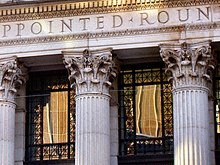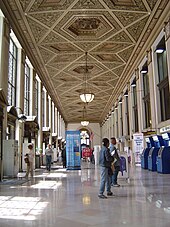US General Post Office

The US General Post Office, also known as the James A. Farley Building , is the main post office in New York City . The post office, built in the style of Beaux Arts architecture , has zip code 10001. The building, designed by McKim, Mead, and White, is the only post office in New York City that is open to the public 24 hours a day, seven days a week Has. As of 2002, 2500 postal workers were working in the building. The building was built in 1912–1914.
The colonnaded building is on the west side of Eighth Avenue , across from Pennsylvania Station and Madison Square Gardens , between 31st and 33rd Streets in Manhattan , where it fills two blocks. It sits over the tracks of the North-East Corridor (Farley Corridor) in western Midtown . It was inscribed on the National Register of Historic Places on January 29, 1973 . The column colonnade is the longest of its kind in the world.
history
The James A. Farley Building was built in two stages. The original monumental front half was built from 1912 and opened to the public in 1914. In 1934, the area of the building was doubled under the then Postmaster General, James A. Farley; the post office on the corner of Park Row and Broadway from 1878 was then closed. On the side façades that lead to Ninth Avenue, the architects have inserted further columns of Corinthian order between the yoke windows. This was done in order to carry the element of the front facade to Ninth Avenue. Farley's construction company General Builders Corporation had received the contract for the extension under the government of US President Herbert Hoover .
The building was one of the last to be built under the Tarsney Act . By 1893, all civil federal institutions were employed by architects in the Office of the Supervising Architect within the United States Department of the Treasury . The 1893 law, introduced by a Missouri Congressman, allowed the supervising architect to select a private architect in a competition. James Knox Taylor selected McKim for the post office. In 1913 the law was partially repealed as a result of a scandal. This was created when Taylor appointed his former partner Cass Gilbert to design the Alexander Hamilton US Custom House .
The monumental facade on Eighth Avenue was laid out as a Corinthian column colonnade and bordered at the ends by two pavilions . The purpose of the imposing design was to match the colonnades of the Pennsylvania Station planned by McKim, Mead, and White in 1910 , which were originally across the street. An uninterrupted row of stairs running the full length of the colonnade gives access to the main floor for customers, which is located above a functional basement. It rises above a dry moat that provides the work rooms in the basement with air and light. Each of the square pavilions is covered by a low, pyramid-shaped roof. Inside, the view of the visitor falls unhindered on a long gallery that runs parallel to the colonnade front. At the north end of it is a small post-historical museum.
In a prominent place, above the column colonnade, is the inscription “ Neither snow nor rain nor heat nor gloom of night stays these couriers from the swift completion of their appointed rounds ”, which is often misunderstood as the motto of the United States Postal Service - it does exist no such official motto - in fact, it was chosen by William Mitchell Kendall. It was this McKim, Mead, and White architectural firm employee who took the sentence from Book 8 (Chapter 98) of the Histories of Herodotus . The passage refers to the faithful service that the mail riders of the Achaemenid Empire rendered under Xerxes I. The design of the inscription was created by Ira Schnapp , who would later create the logo for Action Comics and other DC Comics publications .
When it opened in 1914, the post office was called the Pennsylvania Terminal, in July 1918 it was renamed the General Post Office Building and in 1982 it was renamed the James A. Farley Building. James Farley was the United States' 53rd Postmaster General from 1933–1940 . A native of New York City, Farley played an integral role in the political careers of Alfred E. Smith and Franklin D. Roosevelt, and was himself a candidate for the Democratic nomination convention in 1940 .
"... the life of James A. Farley should serve as an example for current and future generations of Americans of how diligent individual citizens can serve the lives of the entire nation."
The Farley Building played an integral role in the aftermath of the September 11, 2001 terrorist attacks , when the post office took over the functions of Church Street Station Post Office , which was across the street from the World Trade Center .
Remodeling plans
There are plans to use the Farley Building as the new entrance hall to Pennsylvania Station . Apart from the counters for the sale of postal services, priority mail, mail delivery, the ramps for post buses and a stamp warehouse will remain, as will the administrative offices of the Postal Service for New York.
The mail handling facilities, however, are to be relocated one block further to the Morgan Processing and Distribution Center and all other administrative functions are to be relocated to the post office on Church Street. According to these plans, only about 900 jobs will remain at this point.
Web links
- Newpennstation.org (English)
- Farley Post Office / MSG Model (English; PDF file; 739 kB)
- USPS James A. Farley Bio. (English, PDF; 164 kB)
- Farley building architecture (English)
Individual evidence
- ^ National Register of Historical Places - New York (NY), New York County . In: National Register of Historic Places . National Park Service. February 14, 2007. Retrieved January 5, 2011.
- ^ Antoinette J. Lee: Architects to the Nation: The Rise and Decline of the Supervising Architect's Office ( English ). Oxford University Press, April 20, 2000, ISBN 0-19-512822-2 .
- ↑ " Neither snow, nor rain, nor heat nor the darkness of the night prevent these messengers from completing their predetermined rounds quickly "
- ↑ Reed, Robby. "Present at the Creation", Dial B for Blog (Oct. 10, 2006). Retrieved July 21, 2008.
- ↑ Resolution 368 of the House of Representatives, March 2, 1982, 97th Congress. " ... the life of James A. Farley should serve as an example for present and future generations of Americans of the vital contributions which individual citizens can make to the life of the nation through diligent public service ... "
Coordinates: 40 ° 45 '4.4 " N , 73 ° 59" 42.6 " W.


